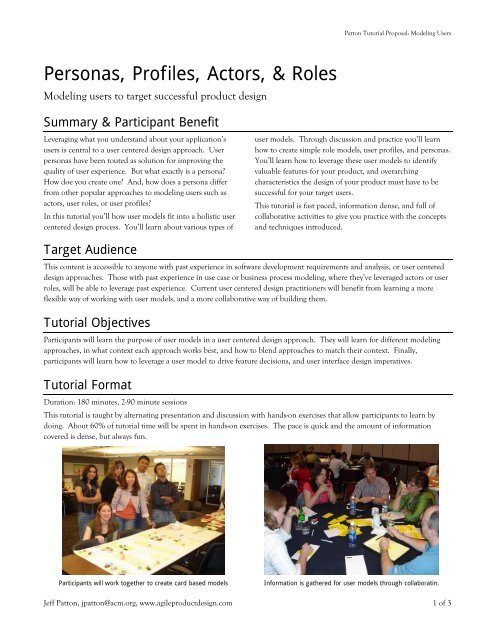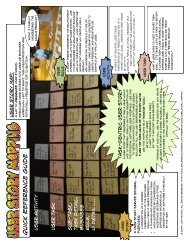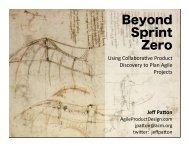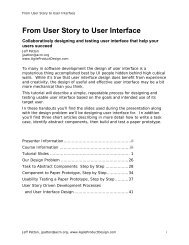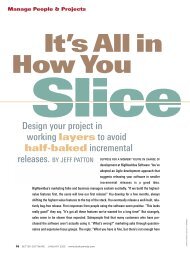Personas, Profiles, Actors, & Roles - Jeff Patton
Personas, Profiles, Actors, & Roles - Jeff Patton
Personas, Profiles, Actors, & Roles - Jeff Patton
Create successful ePaper yourself
Turn your PDF publications into a flip-book with our unique Google optimized e-Paper software.
<strong>Patton</strong> Tutorial Proposal: Modeling Users<br />
<strong>Personas</strong>, <strong>Profiles</strong>, <strong>Actors</strong>, & <strong>Roles</strong><br />
Modeling users to target successful product design<br />
Summary & Participant Benefit<br />
Leveraging what you understand about your application’s<br />
users is central to a user centered design approach. User<br />
personas have been touted as solution for improving the<br />
quality of user experience. But what exactly is a persona<br />
How doe you create one And, how does a persona differ<br />
from other popular approaches to modeling users such as<br />
actors, user roles, or user profiles<br />
In this tutorial you’ll how user models fit into a holistic user<br />
centered design process. You’ll learn about various types of<br />
user models. Through discussion and practice you’ll learn<br />
how to create simple role models, user profiles, and personas.<br />
You’ll learn how to leverage these user models to identify<br />
valuable features for your product, and overarching<br />
characteristics the design of your product must have to be<br />
successful for your target users.<br />
This tutorial is fast paced, information dense, and full of<br />
collaborative activities to give you practice with the concepts<br />
and techniques introduced.<br />
Target Audience<br />
This content is accessible to anyone with past experience in software development requirements and analysis, or user centered<br />
design approaches. Those with past experience in use case or business process modeling, where they’ve leveraged actors or user<br />
roles, will be able to leverage past experience. Current user centered design practitioners will benefit from learning a more<br />
flexible way of working with user models, and a more collaborative way of building them.<br />
Tutorial Objectives<br />
Participants will learn the purpose of user models in a user centered design approach. They will learn for different modeling<br />
approaches, in what context each approach works best, and how to blend approaches to match their context. Finally,<br />
participants will learn how to leverage a user model to drive feature decisions, and user interface design imperatives.<br />
Tutorial Format<br />
Duration: 180 minutes, 2-90 minute sessions<br />
This tutorial is taught by alternating presentation and discussion with hands-on exercises that allow participants to learn by<br />
doing. About 60% of tutorial time will be spent in hands-on exercises. The pace is quick and the amount of information<br />
covered is dense, but always fun.<br />
Participants will work together to create card based models<br />
Information is gathered for user models through collaboratin.<br />
<strong>Jeff</strong> <strong>Patton</strong>, jpatton@acm.org, www.agileproductdesign.com 1 of 3
<strong>Patton</strong> Tutorial Proposal: Modeling Users<br />
A simple process is described for moving from basic user<br />
understanding to a full features personas and product implications<br />
Example user profiles and personas help participants envision the<br />
final outcome<br />
Tutorial Handouts<br />
Handouts will include step-by-step instructions for the techniques discussed. The text will be an early release of material in a<br />
forthcoming book on the subject of collaborative card modeling.<br />
Tutorial Outline<br />
Session One: Creating Simple User Models<br />
90 minutes<br />
Goals<br />
• Understand the where user models fit in a user centered design approach<br />
• Understand <strong>Actors</strong>, <strong>Roles</strong>, <strong>Profiles</strong>, and <strong>Personas</strong> as for simple categorizations of user models<br />
• Understand how one user model can evolve into another based on the project needs<br />
Exercises<br />
• User role Modeling<br />
• User role profiling<br />
Session Two: Leveraging User Models<br />
90 minutes<br />
Goals:<br />
• Understand why and how to communicate user models within your organization<br />
• Leverage user models to identify product feature opportunities<br />
• Leverage user models to identify necessary product design characteristics<br />
Exercises<br />
• Persona poster creation<br />
• Feature and design imperative identification<br />
<strong>Jeff</strong> <strong>Patton</strong>, jpatton@acm.org, www.agileproductdesign.com 2 of 3
<strong>Patton</strong> Tutorial Proposal: Modeling Users<br />
Author Bio: <strong>Jeff</strong> <strong>Patton</strong> | jpatton@acm.org | 801.910.7908<br />
Since 2000, <strong>Jeff</strong> <strong>Patton</strong> has<br />
championed the incorporation<br />
of User Centered Design<br />
thinking into traditional and<br />
Agile software development<br />
approaches. Through writing,<br />
teaching, speaking, and practice <strong>Jeff</strong> works to introduce<br />
developers, analysts, product managers, and others to simple<br />
techniques to help them incorporate UCD thinking and<br />
techniques into their day-to-day work practices. <strong>Jeff</strong> has<br />
found that incorporating user-centric thinking along with<br />
traditional requirements development and testing practices<br />
drives toward the ultimate goal of better software for endusers<br />
and more profitable software for those who pay for its<br />
design and development.<br />
Since 2004 <strong>Jeff</strong> has been a consultant with ThoughtWorks<br />
working in a wide variety of domains from healthcare to<br />
stock portfolio management. Within TW <strong>Jeff</strong> has helped<br />
build the recognition of user-centric thinking as a critical<br />
success factor in their Agile projects. This type of thinking<br />
has been “baked in” to ThoughtWorks QuickStart Analysis<br />
approach.<br />
To help build awareness of the subject of Agile development,<br />
User Centered Design and usability, in 2004 <strong>Jeff</strong> started the<br />
Agile-Usability discussion group hosted by Yahoo Groups.<br />
At over 1,300 members, the group keeps a running dialog on<br />
the subject, and helps provide a starting point for those<br />
interested in getting help applying UCD and usability<br />
practices on Agile projects.<br />
<strong>Jeff</strong> is currently a columnist for StickyMinds.com and IEEE<br />
Software. He’s at work on the forthcoming book “Agile<br />
Development Outside-In” which published by Addison-<br />
Wesley in Cockburn & Highsmith’s Agile Development<br />
series.<br />
Website including writing, past presentations, and blog: www.agileproductdesign.com<br />
Past Presentation Experience<br />
Although this is a new tutorial, it leverages content and card modeling approaches I’ve used for years in past tutorials I’ve been<br />
presenting tutorials and workshops, participating in panel discussions and delivering short invited talks since 2002. The<br />
following is a list of past conferences I’ve participated in:<br />
• XP Universe ’02, ‘04: practitioner report, tutorial<br />
presenter<br />
• OOPSLA ‘02, ’04, ’05, ’06 and ‘07: practitioner reports,<br />
panelist, tutorial presenter<br />
• Constantine & Lockwood’s ForUse ’02 & ’03: tutorial<br />
presenter, panelist, invited presenter<br />
• Agile Development Conference ‘03. ’04, ’05, ’06, and<br />
‘07: practitioner report, workshop presenter, tutorial<br />
presenter<br />
• PLoP ’03, ‘04: paper author, workshop presenter<br />
• UPA ‘04, & ’05: tutorial presenter, workshop presenter,<br />
panelist<br />
• CHI 2006: panelist<br />
• Dr. Dobb’s Architecture & Design World ’06 & ’07:<br />
tutorial presenter<br />
• SD Best Practices 2007: Tutorial presenter<br />
• Ajax Experience 2006: presenter<br />
• Spring Experience 2006: presenter<br />
• UIE 11, 2006: tutorial presenter, speaker<br />
• XP Day London, 2007: keynote speaker, tutorial<br />
presenter<br />
• Better Software Agile Development Conference 2007:<br />
tutorial presenter<br />
In addition to formal presentation at conferences, training on this subject, in various forms, has been presented at several<br />
private companies.<br />
***<br />
<strong>Jeff</strong> <strong>Patton</strong>, jpatton@acm.org, www.agileproductdesign.com 3 of 3


